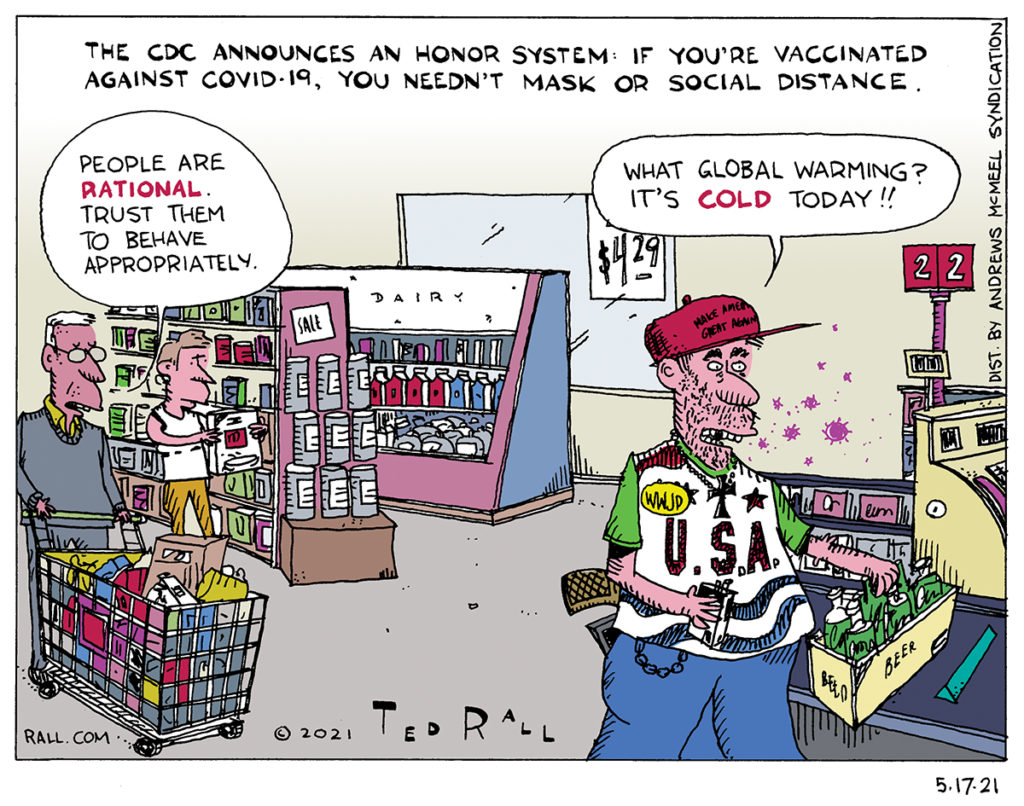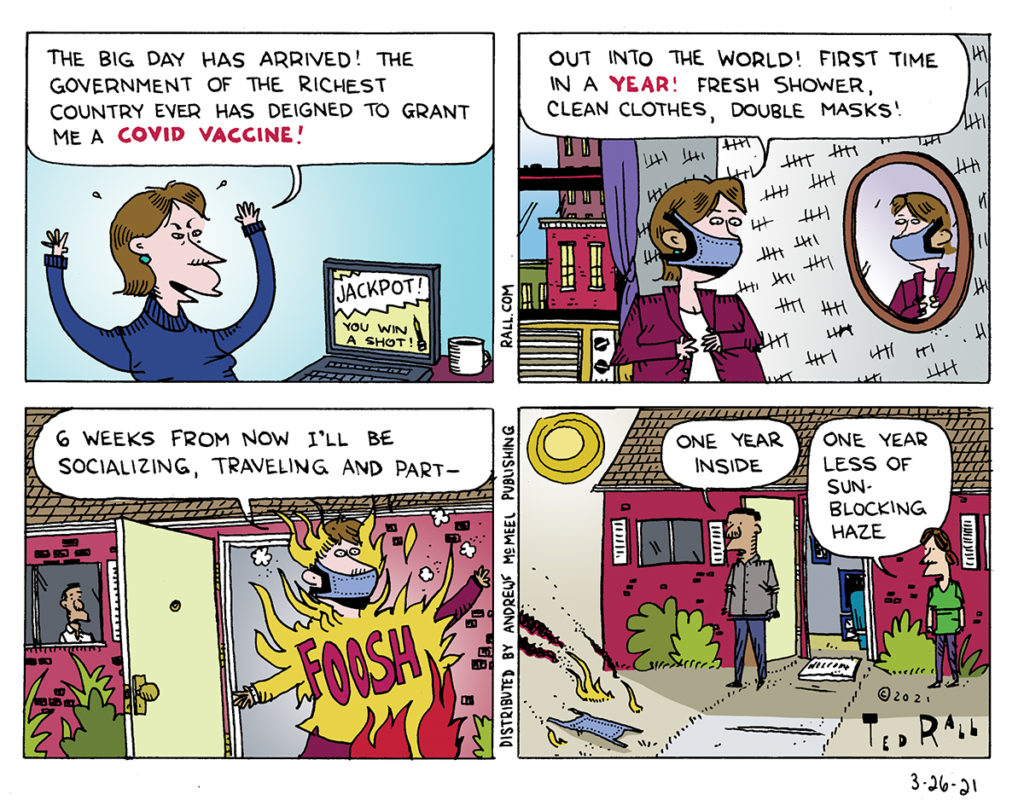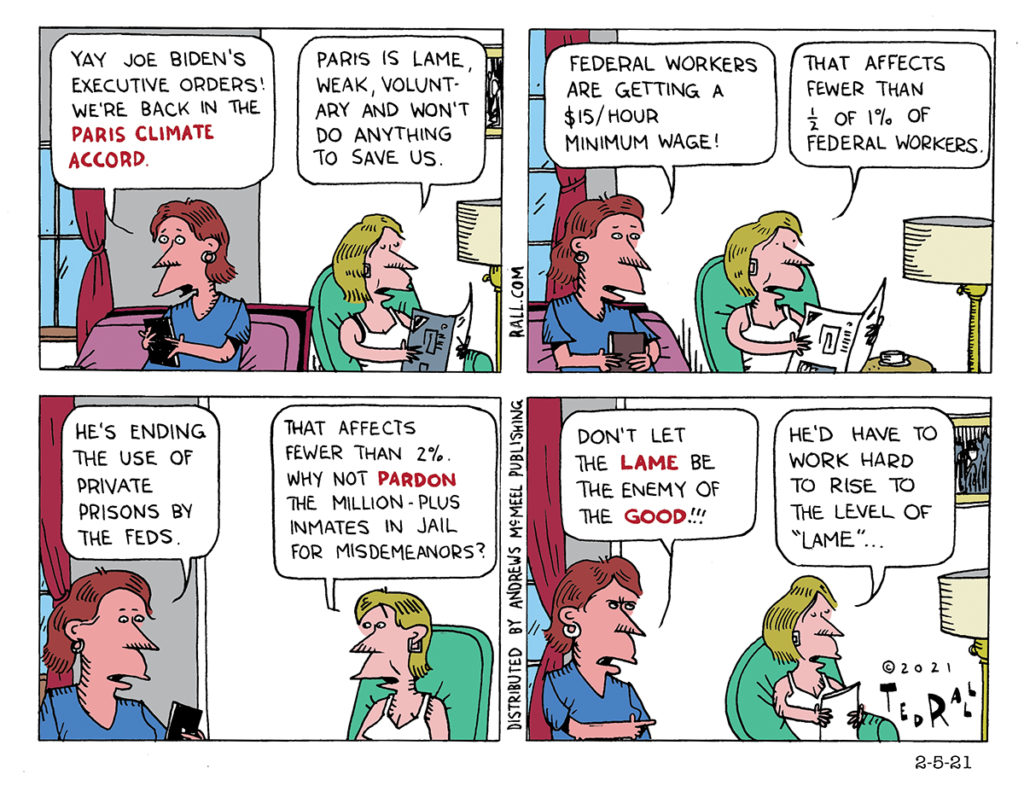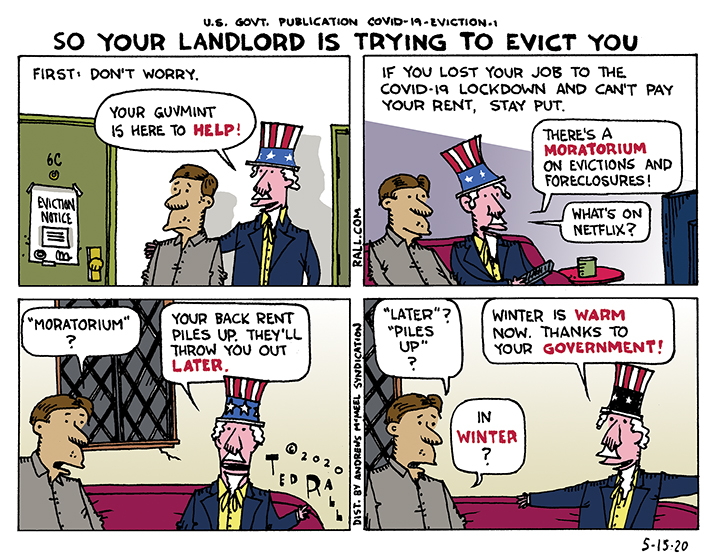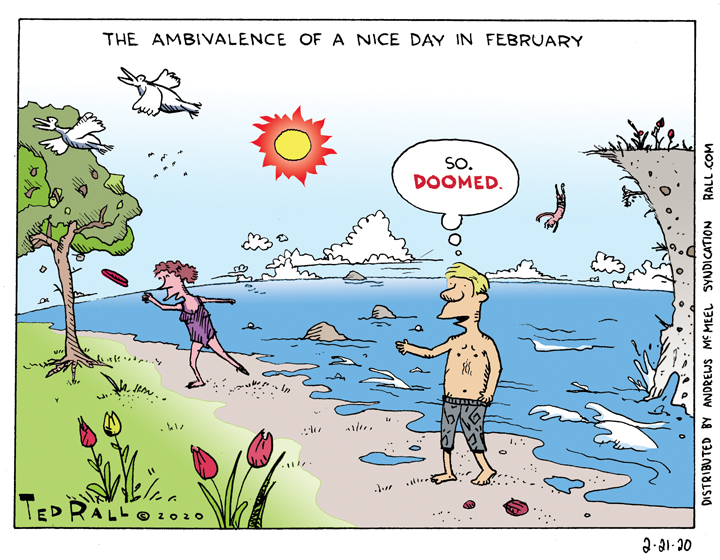The Centers for Disease Control made big news by announcing that people who are fully vaccinated for COVID-19 no longer have to socially distance or wear masks, even indoors.
In Praise of Bad Weather

There is joy in the air. That joy is misplaced.
For that joy might kill us.
I set down these words on the 9th of March in Manhattan. Historically, the average temperature on this day of the year is 40°. If the weather forecast for today, March 9, 2021, is correct, and at this writing it looks like it will be, the temperature will hit 61°.
“Today is going to be a beautiful day,” the radio said this morning.
Everyone is happy. People are making plans to eat outside, go running, walking, whatever, everyone in New York who can break away from work or other obligations is determined to enjoy today’s “good weather.”
I feel it too. I have a meeting after I finish writing this. The sun will feel sweet on my face. More people will be smiling; even if I have to surmise that from the twinkle in their eyes above a mask, their pleasure in this good weather will be infectious.
We have got to stop thinking about warm, sunny, hotter-than-usual weather as positive. Weather isn’t climate. But hotter-than-usual weather multiplied out, repeated as it has been for years, reflects the existential threat of climate change. Hotter-than-usual weather repeated over time is killing coral and plants, extinguishing species of animals. It will ultimately kill us, and if not us, our children, and if not them, our grandchildren. I have not yet met my grandchild, but I don’t want my grandchild, or yours, to die before he or she has his or her own grandchildren.
We’ve been greeting “beautiful days,” i.e. hotter-than-usual days, by pulling on tank tops, grabbing picnic baskets and heading to the park. This is understandable. This is insane.
Celebrating a hotter-than-usual day makes as much sense as a Frenchman jumping for joy at the sight of invading German troops. Sparkling blue, cloudless skies are harbingers of doom. The soft scent of your own sweat under a gentle sun in mid-winter is a death sentence handed down by a judge whose rulings cannot be appealed. When you hear that it’s going to be 61° in Manhattan in March, you should be scared to death.
There are, if you pay attention, signs that everything is wrong. Trees whose first buds appeared in late April now pop out in February, fresh leaves frozen off as the weather turns cold again, though not as cold nor for as long as it should. Asthmatics, those human canaries, suffer from “spring” allergies all “winter” long. There are so few birds.
The proper response to one too many hotter-than-usual days in mid-winter — for that matter, it is also an appropriate way to greet a series of hotter-than-usual days in summer — is fear. We are on the way out. We are killing ourselves. This is seriously messed up.
Anger follows fear. We should hate the ecocidal maniacs who are too greedy and stupid to see that their relentless quest for short-term corporate profits is murdering us. We should despise the politicians who sell us out to these psychos. We should be ashamed of ourselves for tolerating both sets of crazies.
Unless we are idiots, action should come next, and damned soon. The truly great thing about a 61° day in New York City in March (in March!) is that it makes it more enticing for hundreds of thousands of New Yorkers together in public spaces to protest and demand sanity from their overlords. There are no winter coats or cold-stiffened bones to stop demonstrators from hurling teargas canisters back at the cops.
Saving ourselves must begin with a mental shift.
There is, as an older gentleman who drove me in his taxi told me a couple of years ago, no good weather or bad weather. There is only weather. To a farmer, rain is often welcome. To which I would add, given the context of global warming, there is only appropriate weather — appropriate to its time and place and based on the assumption, which needs to become true if we want to live, that the human race is no longer affecting that weather.
An 80° day at the South Pole might be pleasant for sunbathing scientists. But it would be radically inappropriate regardless of the time of year. A 20° day in Bali might be fun for Indonesians who’ve never been in a snowball fight. But it would be wildly wrong, allowing for normal variations of high and low.
I come to you in praise of “bad” weather. On the 9th of March, New Yorkers ought to be happy to see sleet. They should smile at their neighbors as they tiptoe through filthy slush puddles pooled at the street corners. Climate change has turned the world topsy-turvy; in a topsy-turvy world, good weather is bad and bad weather is good.
(Ted Rall (Twitter: @tedrall), the political cartoonist, columnist and graphic novelist, is the author of “Political Suicide: The Fight for the Soul of the Democratic Party.” You can support Ted’s hard-hitting political cartoons and columns and see his work first by sponsoring his work on Patreon.)
Biden Offers Moderate Solutions to Radical Problems

“Radical problems require radical solutions,” I wrote in my 2010 book “The Anti-American Manifesto,” a polemic that calls upon us to save ourselves from imminent social, economic and political collapse by overthrowing the system and rebuilding society from the ground up. We currently face several radical problems. But we’re not likely to rise to the challenge, because the Biden Administration’s adherence to the Democratic Party’s cult of militant moderation ensures that their proposed solutions will mitigate these grave issues—at best—with zero chance of avoiding disaster.
There is a time and a place for tweaks and minor adjustments. You don’t amputate a leg to cure a sprained ankle. Extreme situations require going big; if your oncologist suggests removing half your tumor and then waiting to see how it goes, fire her.
Our planet has cancer. Exponentially increasing temperatures have killed most of the world’s reefs and threaten widespread food shortages and thus political stability. Garbage, toxins and other pollutants are clogging the oceans and poisoning the air. We can debate the specifics but when studies predict the possible collapse of human civilization within 30 years and “a ghastly future of mass extinction,” environmental degradation has obviously become a radical problem.
Despite calling climate change “the number one issue facing humanity,” Joe Biden clearly doesn’t grasp the seriousness of the situation. His plan aims to achieve net-zero carbon emissions by 2050, the same year his plan calls for the elimination of fossil fuels. Grant him this: his plan is achievable. If human civilization vanishes, who in the hellscape will be left to burn fossil fuels?
Biden’s approach to the climate change crisis recalls my metaphorical oncologist, the one who counsels half-measures. Ban fracking on federal lands though most oil and gas comes from elsewhere. Improving fuel economy standards; Detroit is moving quickly to an all-electric car future anyway. Seal off leaking oil and gas wells. It’s good stuff. It moves in the right direction. But it’s like taking out half the tumor. Half of it is still inside you, multiplying.
You’re still going to die.
You could even argue that Biden is making things worse. Democrats are breathing a sigh of relief that Trump, a science denialist who wants to mine coal even though energy companies do not, has been replaced by a president who acknowledges the issue. But Biden’s half-measures are no likelier to fix the problem of rising temperatures fueled by greenhouse gas emissions than Trump’s overt sabotage. Catastrophe is inevitable either way.
From geoengineering to synthetic trees that absorb carbon dioxide more efficiently to whitening the surface area of the earth to reflect the sun’s rays to actively promoting algae blooms, science offers a number of Hail Mary passes that might stave off environmental apocalypse. Many sound wacky. They might be counterproductive. But at least they’re radical. Which means that, unlike tweaking MPGs, they might work.
The COVID-19 pandemic reiterated what anyone who ever gets sick has long known: America’s healthcare system is hobbled by rapacious for-profit insurance companies. I have a “silver plan” (Anthem BlueCross BlueShield) purchased via New York State’s Affordable Care Act marketplace. When I arrived at the hospital two weeks ago for a hernia repair operation that I definitely needed—I was losing feeling in my upper legs—I was informed hours before surgery that I would have to cough up $6500 between the deductible and the co-pay. I am due for a colonoscopy but now I can’t afford one. And I’m relatively lucky; I’m not one of the one out of four Americans who routinely skip seeing a doctor because they are too poor.
As with climate change, healthcare in the United States is a radical problem in need of a radical solution. Studies consistently show that Americans rank last or close to last among industrialized nations in terms of access to medical care, quality of care and cost. Average life expectancy in the United States has been falling over the last three years — a radical reversal of 20th century trends that recalls Russia after the collapse of the Soviet Union. Nothing Biden has in mind would put us where we belong: number one.
Biden’s moderate sales pitch famously defeated Bernie Sanders, for whom a major platform plank was Medicare for All. During the campaign Biden repeated Obama’s 2008 pledge to add “a public option” to Obamacare (Obama reneged). But the scheme recently unveiled by the White House downplays the public option and would allow Americans to spend up to 8.5% of their annual income on healthcare.
The new president is inheriting big, long-neglected problems that require big dramatic solutions.
The average young college graduate leaves with over $32,000 in student loan debt. Default rates hover around 10%; even bankruptcy doesn’t allow people to discharge these debts. Hobbling our best and brightest minds shrinks the consumer economy and discourages entrepreneurship. Yet Biden only wants to forgive up to $10,000 — and it doesn’t seem to be a top legislative priority. Even if he gets what he wants, the problem will remain extreme.
According to the Economic Policy Institute, the U.S. labor market is 9.9 million jobs smaller than pre-pandemic levels. New York City alone lost 1 million jobs to the COVID-19 lockdown. Millions of families face destitution, eviction or foreclosure. By any measure, this is a huge problem that could slow recovery for a long time. Biden’s solution is a one-time payment of $1400. Better than nothing but a rounding error compared to what would be required to keep people in their homes while they’re waiting for employment opportunities to return.
As Democrats bask in the glow of impeaching Donald Trump for a second time with some bipartisan support, they may want to consider how he got elected. Desperate workers in flyover country suffered from deindustrialization for years. It was a radical disruption. But Democrats ignored them, exacerbated the problem with poorly-written free trade agreements or satisfied themselves with half-measures.
Here we go again.
(Ted Rall (Twitter: @tedrall), the political cartoonist, columnist and graphic novelist, is the author of “Political Suicide: The Fight for the Soul of the Democratic Party.” You can support Ted’s hard-hitting political cartoons and columns and see his work first by sponsoring his work on Patreon.)
It’s Not That Biden Is Too Slow. It’s That He’s Going Too Small.

In the intraparty Democratic war between progressive leftists and corporate centrists, each side speaks a different language. The two factions’ takes on Joe Biden’s first weeks as president starkly demonstrate that inability to communicate.
Biden’s base is his centrist supporters, those who backed him against Bernie Sanders during the primaries on the grounds that his moderate demeanor and years of wheeling and dealing would allow him to find common ground with Republicans who would probably continue to control the Senate. Centrists’ response to criticism of Biden is that Donald Trump’s mishandling of the coronavirus crisis, the shattered economy and the deep wound to our national psyche caused and embodied by the January 6th Capitol insurrection will require a long time to fix. Impatience, they say, is unrealistic and unfair.
The same principle applies to Biden’s response to longer-standing policy issues that predate Trump, like climate change and the healthcare system. They say, he just moved into the White House. Chill.
But progressives aren’t complaining that Biden is too slow—although they obviously feel a sense of urgency. They are complaining that his policy prescriptions are too small.
Biden came out of the gate fast with dozens of executive orders. But policy-obsessed progressive populists weren’t impressed by their close-to-nonexistent impact.
On January 22nd the president issued a mandate that federal workers become subject to a $15-an-hour minimum wage. Given that the “Fight for $15” movement began in 2012, satisfying that progressive demand would require $17 after adjusting for inflation. More vexing is that Biden’s order doesn’t do anything. According to the U.S. Office of Personnel Management fewer than 20,000 of the nation’s 2.1 million federal government employees—fewer than one percent—currently earn less than $15 an hour. The administration made a splash but 99% of federal workers won’t see an extra penny.
Biden claims that he wants to reform American prisons, an idea for which progressives have been fighting and where common ground with Republicans may be achievable. But his executive order, which tells the Department of Justice not to renew contracts with privately-operated, for-profit prisons, affects only 14,000 out of nearly 152,000 federal inmates currently incarcerated, or fewer than 10% of federal prisoners. There were 1.8 million people in American prisons as of the middle of last year. Biden’s executive order will lead to the transfers of fewer than 1% of the total prison population.
“When it comes to private prisons, the impact of this order is going to be slight to none,” Fordham law professor John Pfaff tells NBC News. Because it fools us into believing in a nonexistent improvement it might even make things worse. “The symbolism carries the very real risk of making us blind to the nearly identical incentives of the public prison sector, and the public side is so much vaster in scope,” Pfaff warns.
One Biden order promises to replace the federal government fleet of 645,000 vehicles with electric ones. The catch is, he doesn’t say when. Unless it happens before 2035 and no future administration issues another executive order reversing this one, companies like General Motors will render the issue moot. The automaker has announced that it will stop making gas-powered passenger cars and SUVs that year.
I was pleasantly surprised by Biden’s decision to push his $1.9 trillion COVID-19 stimulus package through Congress using the budget reconciliation process, which only requires 50 votes rather than a 60-vote supermajority in the Senate. Democrats finally seem to be waking up to the reality that Republicans really, really hate them and aren’t going to cooperate with their initiatives. But here’s the thing: neither the one-time $1400 per person payout nor the $15/hour minimum wage can lift us out of the deep coronavirus depression. The American workforce has lost at least 10 million jobs over the last year. Millions of people face eviction or foreclosure. There is widespread consensus among economists that Biden’s plan, assuming it passes intact, is insufficient and will fail to provide long-lasting relief.
If Biden has big plans in mind, now—while Democrats control the Senate and he enjoys high approval ratings—is the time to tee them up.
First, the president should communicate to the public that sizable coronavirus relief packages will be an ongoing part of fiscal policy until the pandemic is over, recovery is at hand and the rising tide has already begun to lift most boats. The current ad hoc approach inherited from Trump is woefully inadequate and creates unnecessary anxiety among individuals and in the securities markets. Stimulus in fits and starts doesn’t work. We need a Universal Basic Income.
Second is the environment. Long neglected by both major parties, the climate change crisis represents both an enormous opportunity as well as an existential threat to humanity. Auto manufacturers that are rapidly moving toward electric vehicles and big energy companies that already understand the future lies outside fossil fuels prove that the marketplace is ahead of government when it comes to the Green New Deal. Biden deserves credit for talking about the problem but he wants to do way too little way too late.
He should work to push through a comprehensive plan to radically reduce the emission of greenhouse gases within the next few months.
There are, of course, a myriad of other policy challenges ahead—militarism, immigration, an increasingly authoritarian Silicon Valley—but if I were Biden I would tackle racism and particularly racist policing quickly. American police are vicious, stupid and predatory. They make communities more dangerous, not safer. Cops should get out of the revenue enhancement business. Protecting the public must take priority over protecting themselves. Harassing people based on ethnicity and other demographic profiles must end. Biden can use the threat of withholding federal funding to force states and cities to reinvent policing from the ground up.
We want Biden to be fast. More than that, though, we want him to be bold.
(Ted Rall (Twitter: @tedrall), the political cartoonist, columnist and graphic novelist, is the author of “Political Suicide: The Fight for the Soul of the Democratic Party.” You can support Ted’s hard-hitting political cartoons and columns and see his work first by sponsoring his work on Patreon.)
In a Crisis, a Compromise Solution Is Worse Than No Solution at All
The raging argument on the left between progressives who argue for radical change and centrists who advocate incrementalism is hardly new. Nearly a century ago, progressive titan and Wisconsin governor Robert La Follette and FDR were often at loggerheads over the same question.
Roosevelt, La Follette complained, was too quick to compromise with reactionaries. FDR insisted that “half a loaf is better than no bread.” While that might seem intuitively obvious, La Follette had a ready reply. “Half a loaf, as a rule, dulls the appetite, and destroys the keenness of interest in attaining the full loaf.” That can be dangerous. The average adult male requires approximately 2500 calories of nutrition per day. 1250 is better than 0, but 1250 is still malnutrition that would eventually kill him.
Even in a long-running crisis, the sustained agitation necessary to pressure the political classes into granting concessions doesn’t usually occur before people’s suffering has become acute. If the powers that be provide partial relief in the form of a half-measure that partly alleviates a problem, angry citizens can be persuaded to put down their pitchforks and go home peaceably. Yet the problem persists.
The Affordable Care Act is a perfect example. Obama became president at the peak of a major economic crisis, the subprime mortgage meltdown of 2007-09. With hundreds of thousands of people losing their jobs every month, the need for government intervention in the healthcare system was obvious to most Americans. So Obama campaigned on major change that included a public option. Two out of three people, including many Republicans, favored a single-payer system similar to those in many other countries.
Instead, we got the watered-down ACA.
As COVID-19 has made clear, the for-profit American healthcare system is even more scandalously dysfunctional than it was prior to the passage of Obamacare. The ACA “marketplace” has collapsed; many places only offer one “take it or leave it” insurance plan. Nevertheless, healthcare is no longer a top political issue. Support for a public option or Medicare For All has dropped to about 50%. The Democratic Party chose to nominate someone who promised to veto Medicare For All even if both houses of Congress were to pass it.
Tens of thousands of people are still dying every year because they can’t afford to see a doctor. But in too many people’s minds, healthcare was partly solved. So they are no longer demanding improvements. Though it might seem counterintuitive, the politics of the healthcare crisis would be vastly improved had the compromise ACA never been enacted. More people would be suffering. But the absence of an existing, lame, plan would add urgency (and supporters) to the fight for a real, i.e. radical, solution.
Half a loaf is killing us.
As Joe Biden fills his cabinet with Obama-era centrists and corporatists, many Democrats say they are satisfied with the improvement over Trump: officials with government experience replacing crazies and cronies, pledges to reverse the outgoing administration’s attacks on the environment, fealty to science. They are falling into La Follette’s “half a loaf” trap. Especially on existential issues like climate change but also regarding the precarious state of the post-lockdown economy, compromise will sate the appetite for meaningful change without actually solving the problems. As with the ACA, voters will be deceived into thinking things are getting better when in fact they will still be getting worse, albeit perhaps at a slightly slower rate.
Climate scientists are divided between those who say we might be able to save human civilization if we achieve zero net carbon emissions within a decade (which is the goal of the Green New Deal pushed by progressives), and those who say it’s already too late. A widely reported study predicts that human civilization will collapse by 2050, yet that’s the year Biden is promising to begin zero net carbon emissions. So if we do what Biden wants, we are going to die.
Trump denied climate science, deregulated polluters and pulled the U.S. out of the Paris Accord. Biden appears to be an improvement. He talks about the urgency of the problem, promises to restore Obama-era regulations and to rejoin the Paris Agreement. Pro-environment Democratic voters are breathing a sigh of relief.
But if the goal is to slow the rate of global warming as much as we reasonably can, both Obama’s regulations and the Paris Agreement are woefully inadequate. “Marginal cuts by the U.S. don’t have a long-term overall big effect on the climate,” Michael Oppenheimer, professor of geosciences and international affairs at Princeton University, told Scientific American in 2014.
A 2017 report by the United Nations Environment Program found that “if action to combat climate change is limited to just current pledges, the Earth will get at least 3°C (5.4°F) warmer by 2100 relative to preindustrial levels. This amount of warming would vastly exceed the Paris Agreement’s goal, which is to limit global warming by the end of the century to 2°C (3.6°F),” reported National Geographic.
“[3°C increase] would bring mass extinctions and large parts of the planet would be uninhabitable,” the UNEP warned in 2019.
If liberals head back to brunch in a month thinking that the Biden Administration will move the needle in the right direction, if they stop being terrified, we are doomed. For as bizarre as it sounds, Donald Trump provided a valuable service when he scared the living daylights out of us.
Consider a more modern analogy than the loaf of bread: if a two-pill dose of antibiotics is required to cure an illness, taking one instead doesn’t make you half better. It actually makes you worse because not only do you not get better, you destroy your immune system’s ability to fight the disease.
This country is teetering on the verge of collapse. We can’t afford to settle for the single-pill solutions of incremental Bidenism.
(Ted Rall (Twitter: @tedrall), the political cartoonist, columnist and graphic novelist, is the author of “Political Suicide: The Fight for the Soul of the Democratic Party.” You can support Ted’s hard-hitting political cartoons and columns and see his work first by sponsoring his work on Patreon.)

